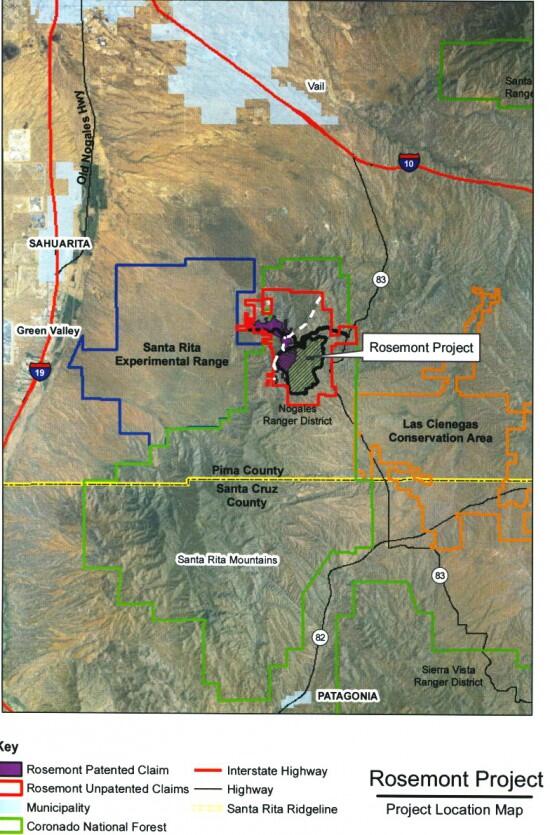
Credit: Photo by Tom Vezo/Save the Scenic Santa Ritas via Earth Island Journal
Original article by Rosemont Mine Truth
The Coronado National Forest’s proposed final environmental impact study for the Rosemont copper mine is drawing sharp criticism from Pima County’s top administrator. and two U.S. Congressmen from southern Arizona.
Pima County is demanding that a new study be prepared in written comments submitted in response to the CNF’s proposed Final Environmental Impact Statement (FEIS) for the massive copper mine.
“Relying upon this document for your decision as to whether to permit the mine’s destruction of thousands of acres of public Forest land, will surely result in lengthy challenges,” Pima County Administrator Chuck Huckelberry states in an Aug. 14 letter to the CNF Supervisor Jim Upchurch.
The proposed FEIS, Huckelberry states, “is still incomplete in many ways and lacks information required to be included in a Final EIS.”
U.S. Representatives Raul Grijalva and Ron Barber, meanwhile, sent a joint, Aug. 15 letter to Agriculture Secretary Tom Vilsack urging him to “ensure the Forest Service fully and completely analyze the impacts of this mining project.”
The Congressmen stated the Pima County has “stressed the importance of a thorough environmental impact study” and that the “concerns of Pima County and all local stakeholders are critical to ensuring any environmental evaluation is conducted correctly.”
The Congressmen noted that when the proposed FEIS was released on July 1, it was missing essential elements including analysis of endangered species impacts, consultation with Native American communities regarding impact to historical and cultural sites, Clean Water Act permits and responses to public comments.
“Because of this, we believe the Forest Service should take as much time as is needed in order to ensure a thorough and complete review,” Barber and Grijalva wrote.
The Final EIS that is ultimately released by the Forest Service will be used by the U.S. Army Corps of Engineers to determine whether to issue a Clean Water Act permit for the mine.
Huckelberry said that having the Corps rely on an inadequate FEIS in its decision on whether to issue a Clean Water Act permit allowing Rosemont to “fill, destroy and pollute area waterways, springs and seeps will also prove problematic.”
The mine cannot be built without the Clean Water Act permit. The U.S. Environmental Protection Agency has veto authority over Clean Water Act permits and has expressed serious concerns about the mine’s impact on Arizona’s waterways.
CNF Supervisor Jim Upchurch has stated in published reports that he wants to release the FEIS before new regulations take effect on Sept. 27 to meet the needs of Vancouver, B.C.-based Augusta Resource Corp. Augusta is seeking state and federal permits through its wholly-owned subsidiary, Rosemont Copper Company, to construct the mine in the Santa Rita Mountains on the CNF.
The new regulations would require at least 90 days of additional consultations between the Forest Service and mine opponents before the FEIS could be completed. Cash-strapped Augusta stated in an Aug. 14 regulatory filing that a delay in issuing the FEIS until early next year would cost the company a minimum of $29 million.
The Congressmen’s letter to Vilsack criticized Upchurch’s efforts to “fast track” publication of the FEIS prior to new regulations in order to accommodate Augusta’s needs.
“The Forest Service promulgated these regulations for the explicit purpose of resolving conflicts prior to a decision and there is no need to avoid following them for this particular FEIS,” they wrote.
Pima County submitted more than 300 pages of comments to the proposed FEIS. The county was particularly concerned about the lack of mitigation that will be required to compensate for the massive environmental impact of the proposed mine.

Huckelberry stated that the “level of mitigation proposed is inadequate to offset the significant adverse and irreversible permanent impacts” of the mine.
Pima County, he said, is very concerned that a “loophole big enough to drive a mine truck through it” in connection with mitigation could lead to a scenario “where the public will be left with a mess; and the taxpayers will be on the financial hook for corrective action.”